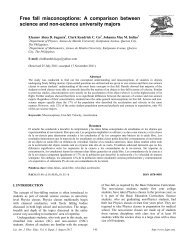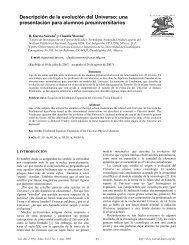Jerk, Curvature and Torsion in Motion of Charged Particle
Jerk, Curvature and Torsion in Motion of Charged Particle
Jerk, Curvature and Torsion in Motion of Charged Particle
You also want an ePaper? Increase the reach of your titles
YUMPU automatically turns print PDFs into web optimized ePapers that Google loves.
<strong>Jerk</strong>, curvature <strong>and</strong> torsion <strong>in</strong> motion <strong>of</strong> charged<br />
particle under electric <strong>and</strong> magnetic fields<br />
A. Tan <strong>and</strong> M. Dokhanian,<br />
Department <strong>of</strong> Physics, Alabama A & M Universty, Normal, Alabama 35762, U.S.A.<br />
E-mail: arjun.tan@aamu.edu<br />
(Received 20 October 2011, accepted 18 December 2011)<br />
Abstract<br />
The existence <strong>of</strong> the jerk vector <strong>and</strong> the result<strong>in</strong>g curvature <strong>and</strong> torsion are <strong>in</strong>vestigated <strong>in</strong> the motion <strong>of</strong> a charged<br />
particle under the <strong>in</strong>fluence uniform <strong>of</strong> electric <strong>and</strong> magnetic fields. It is shown that a uniform electric field, by itself,<br />
does not produce jerk <strong>and</strong> hence cannot create torsion. It produces curvature if the <strong>in</strong>itial velocity <strong>of</strong> the charged<br />
particle has a component perpendicular to the electric field. A uniform magnetic field, on the other h<strong>and</strong>, produces jerk<br />
motion, <strong>and</strong> curvature <strong>and</strong> torsion <strong>of</strong> constant magnitudes. The perpendicular <strong>and</strong> parallel components <strong>of</strong> the <strong>in</strong>itial<br />
velocity <strong>of</strong> the particle are responsible for the curvature <strong>and</strong> torsion, respectively. When electric <strong>and</strong> magnetic fields<br />
parallel with one another are present, they both contribute to curvature <strong>and</strong> torsion. The path is a helix which is<br />
cont<strong>in</strong>uously be<strong>in</strong>g stretched out. As a result, both curvature <strong>and</strong> torsion approach zero as time progresses.<br />
Keywords: <strong>Jerk</strong> vector, <strong>Curvature</strong>, <strong>Torsion</strong>.<br />
Resumen<br />
La existencia del vector <strong>Jerk</strong> y la curvatura y torsión resultantes son <strong>in</strong>vestigadas en el movimiento de una partícula<br />
cargada bajo la <strong>in</strong>fluencia de los campos eléctricos y magnéticos. Se ha demostrado que un campo eléctrico uniforme,<br />
por sí solo, no produce <strong>Jerk</strong> y por lo tanto no puede crear torsión. Esto produce una curvatura si la velocidad <strong>in</strong>icial de<br />
la partícula cargada tiene una componente perpendicular al campo eléctrico. Un campo eléctrico uniforme, por el<br />
contrario, produce un movimiento <strong>Jerk</strong>, y la curvatura y torsión de las magnitudes constantes. Los componentes<br />
perpendicular y paralela de la velocidad <strong>in</strong>icial de la partícula son responsables de la curvatura y la torsión<br />
respectivamente. Cu<strong>and</strong>o los campos eléctricos y magnéticos paralelos entre sí están presentes, estos contribuyen a la<br />
curvatura y la torsión. El cam<strong>in</strong>o es una hélice que está siendo cont<strong>in</strong>uamente extendida. Como resultado de ello, tanto<br />
la curvatura y la torsión tienden a cero, como pasa el tiempo.<br />
Palabras clave: Vector <strong>Jerk</strong>, Curvatura, Torsión.<br />
PACS: 45.50.-j, 45.50.Dd, 45.40.Aa, 45.40.Bb, 45.40.Gj ISSN 1870-9095<br />
I. INTRODUCTION<br />
One <strong>of</strong> the relatively neglected topics <strong>in</strong> physics is the jerk<br />
vector. Formerly known as the second acceleration, it is the<br />
derivative <strong>of</strong> the acceleration vector, or the third derivative<br />
<strong>of</strong> the position vector, with respect to time. Nonetheless, the<br />
jerk vector has been studied <strong>in</strong> simple harmonic motion [1],<br />
uniform circular motion [2], Keplerian motion [1, 3], <strong>and</strong><br />
projectile motion [4]. In this paper, we <strong>in</strong>vestigate the<br />
existence <strong>of</strong> the jerk vector <strong>in</strong> the motion <strong>of</strong> a charged<br />
particle under the action <strong>of</strong> uniform electric <strong>and</strong> magnetic<br />
fields.<br />
Two other concepts related to a curve <strong>and</strong> seldom<br />
mentioned <strong>in</strong> physics are the curvature <strong>and</strong> torsion. The<br />
curvature is the arc-rate <strong>of</strong> turn<strong>in</strong>g <strong>of</strong> the tangent vector <strong>in</strong> a<br />
plane, whereas the torsion, formerly called the second<br />
curvature, is the arc-rate <strong>of</strong> turn<strong>in</strong>g <strong>of</strong> the tangent out <strong>of</strong> the<br />
plane [5, 6]. These concepts <strong>of</strong> differential geometry are<br />
well-suited to dynamical problems when the curve under<br />
consideration is the trajectory <strong>of</strong> a particle. If the first three<br />
derivatives <strong>of</strong> the position vector <strong>in</strong> time, viz., the velocity,<br />
acceleration <strong>and</strong> the jerk vectors are v , a <strong>and</strong> j ,<br />
respectively, then the curvature <strong>and</strong> torsion are given<br />
by [7]:<br />
<br />
v a<br />
, (1)<br />
3<br />
v<br />
Lat. Am. J. Phys. Educ. Vol. 5, No. 4, Dec. 2011 667 http://www.lajpe.org<br />
<strong>and</strong><br />
v<br />
<br />
a<br />
j <br />
. (2)<br />
2<br />
v a<br />
Us<strong>in</strong>g the above formulas, one can conveniently calculate<br />
the jerk, curvature <strong>and</strong> torsion for the charged particle<br />
motion under the <strong>in</strong>fluence <strong>of</strong> electric <strong>and</strong> magnetic fields.<br />
The equation <strong>of</strong> motion <strong>of</strong> a charged particle <strong>of</strong> mass m<br />
<strong>and</strong> electric charge q under the electric field E <br />
<strong>and</strong>
A. Tan <strong>and</strong> M. Dokhanian<br />
magnetic field B <br />
is given by the Lorentz equation. In<br />
Gaussian system <strong>of</strong> units, we have:<br />
<br />
dv <br />
m qE qv B . (3)<br />
dt<br />
II. MOTION OF CHARGED PARTICLE IN<br />
UNIFORM ELECTRIC FIELD<br />
We first <strong>in</strong>vestigate the motion <strong>of</strong> a charged particle <strong>in</strong> a<br />
uniform electric field. In this <strong>and</strong> the follow<strong>in</strong>g ezamples,<br />
we consider a positive charge (q > 0). Choose the electric<br />
<br />
field <strong>in</strong> the positive x-direction: E Exˆ<br />
. Without loss <strong>of</strong><br />
generality, choose the <strong>in</strong>itial velocity <strong>of</strong> the particle as<br />
<br />
v v xˆ<br />
v yˆ<br />
. Further, let the <strong>in</strong>itial position <strong>of</strong> the<br />
0 <br />
particle be at the orig<strong>in</strong>. The equations <strong>of</strong> motion are the<br />
follow<strong>in</strong>g:<br />
<strong>and</strong><br />
dv x <br />
dt<br />
, (4)<br />
dv y<br />
0 , (5)<br />
dt<br />
dv z 0<br />
dt<br />
. (6)<br />
where qE / m . Integrat<strong>in</strong>g Eqs. (4-6) twice with respect<br />
to time, we get:<br />
<strong>and</strong><br />
v x<br />
t<br />
, (7)<br />
C 1<br />
1 2<br />
x t<br />
C1t<br />
C2<br />
, (8)<br />
2<br />
v y C 3 , (9)<br />
y C t , (10)<br />
3 C 4<br />
v z C 5 , (11)<br />
z C t . (12)<br />
5 C 6<br />
where C 1 , C 2 , etc., are the constants <strong>of</strong> <strong>in</strong>tegration. The<br />
<strong>in</strong>itial conditions give: C1 v<br />
; C 2 0 ; C 3 v<br />
;<br />
C 4 0 ; C 5 C6<br />
0 . Thus the motion is entirely <strong>in</strong> the x -<br />
y plane with<br />
Elim<strong>in</strong>at<strong>in</strong>g t between Eqs. (13) <strong>and</strong> (14), we get<br />
v 2<br />
x y y . (15)<br />
v 2v<br />
<br />
2<br />
<br />
Thus the path <strong>of</strong> the charged particle is a parabola (Fig. 1).<br />
FIGURE 1. <strong>Charged</strong> particle <strong>in</strong> a uniform electric field.<br />
The acceleration <strong>and</strong> jerk vectors are obta<strong>in</strong>ed by<br />
successive differentiation <strong>of</strong> the velocity vector, giv<strong>in</strong>g:<br />
<strong>and</strong><br />
<br />
v <br />
v<br />
txˆ<br />
v yˆ<br />
<br />
<br />
, (16)<br />
<br />
a xˆ<br />
, (17)<br />
<br />
0 <br />
j . (18)<br />
The curvature <strong>and</strong> torsion can readily be calculated us<strong>in</strong>g<br />
Eqs. (1) <strong>and</strong> (2), giv<strong>in</strong>g:<br />
<strong>and</strong><br />
z<br />
v ┴<br />
y<br />
װv<br />
v<br />
<br />
, (19)<br />
2 2 3/ 2<br />
<br />
v<br />
t<br />
v<br />
<br />
0 . (20)<br />
Hence, an electric field can create curvature <strong>in</strong> the motion<br />
<strong>of</strong> a charged particle but not torsion. From Eq. (19), it<br />
follows that as t , 0 , i.e., the curvature<br />
dim<strong>in</strong>ishes <strong>in</strong> time. Also, if v 0 , then 0 . Thus, it is<br />
the perpendicular component <strong>of</strong> the <strong>in</strong>itial velocity which is<br />
responsible for produc<strong>in</strong>g the curvature.<br />
III. MOTION OF CHARGED PARTICLE IN<br />
UNIFORM MAGNETIC FIELD<br />
E<br />
x<br />
1 2<br />
We next <strong>in</strong>vestigate the motion <strong>of</strong> a charged particle <strong>in</strong> a<br />
x v t t<br />
, (13)<br />
2<br />
uniform magnetic field. Choose the magnetic field <strong>in</strong> the<br />
<br />
<strong>and</strong><br />
positive x-direction: B Bxˆ<br />
. Without loss <strong>of</strong> generality,<br />
y vt<br />
. (14)<br />
choose the <strong>in</strong>itial velocity <strong>of</strong> the particle as<br />
Lat. Am. J. Phys. Educ. Vol. 5, No. 4, Dec. 2011 668 http://www.lajpe.org
<strong>Jerk</strong>, <strong>Curvature</strong> <strong>and</strong> <strong>Torsion</strong> <strong>in</strong> <strong>Motion</strong> <strong>of</strong> <strong>Charged</strong> <strong>Particle</strong> Under Electric <strong>and</strong> Magnetic Fields<br />
<br />
v0 v xˆ<br />
v<br />
yˆ<br />
. Further, let the <strong>in</strong>itial position vector <strong>of</strong><br />
v<br />
v<br />
<br />
r vtxˆ<br />
s<strong>in</strong> tyˆ<br />
cos tzˆ<br />
, (34)<br />
the particle be r z0<br />
zˆ<br />
. The equations <strong>of</strong> motion are the<br />
<br />
follow<strong>in</strong>g:<br />
<strong>and</strong><br />
<br />
dv v v xˆ<br />
v cos tyˆ<br />
v<br />
s<strong>in</strong> tzˆ<br />
x 0<br />
dt<br />
, (21)<br />
<br />
. (35)<br />
<strong>and</strong><br />
dv<br />
dv<br />
dt<br />
dt<br />
z<br />
y<br />
v<br />
, (22)<br />
z<br />
v<br />
. (23)<br />
y<br />
v ┴<br />
y<br />
B<br />
where qB / m is the gyr<strong>of</strong>requency. The solutions to Eq.<br />
(21) subject to the <strong>in</strong>itial conditions are:<br />
װv<br />
x<br />
<strong>and</strong><br />
v x v , (24)<br />
x v t . (25)<br />
<br />
z<br />
FIGURE 2. <strong>Charged</strong> particle <strong>in</strong> a uniform magnetic field.<br />
Eqs. (23) <strong>and</strong> (24) are coupled equations. Differentiat<strong>in</strong>g<br />
each <strong>and</strong> substitut<strong>in</strong>g from the other, one gets:<br />
<strong>and</strong><br />
d<br />
d<br />
2<br />
dt<br />
v<br />
2<br />
y<br />
2<br />
vz<br />
2<br />
dt<br />
<br />
<br />
Let the solution to Eq. (26) be<br />
v y<br />
2<br />
2<br />
v<br />
v<br />
y<br />
z<br />
0 , (26)<br />
0 . (27)<br />
C1 s<strong>in</strong> t<br />
C2<br />
cos t<br />
, (28)<br />
Eq. (34) is the parametric equation <strong>of</strong> a helix about the x-<br />
axis hav<strong>in</strong>g radius v <strong>and</strong> pitch v t (Fig. 2).<br />
/<br />
The acceleration <strong>and</strong> jerk vectors are obta<strong>in</strong>ed by<br />
successive differentiation <strong>of</strong> the velocity vector, giv<strong>in</strong>g:<br />
<strong>and</strong><br />
<br />
a v<br />
s<strong>in</strong><br />
tyˆ<br />
v<br />
cos<br />
tzˆ<br />
, (36)<br />
<br />
<br />
j v<br />
<br />
<br />
2<br />
<br />
cos tyˆ<br />
v <br />
<br />
2<br />
s<strong>in</strong> tzˆ<br />
. (37)<br />
The curvature <strong>and</strong> torsion can readily be calculated us<strong>in</strong>g<br />
Eqs. (1) <strong>and</strong> (2). Upon carry<strong>in</strong>g out the calculations, one<br />
obta<strong>in</strong>s:<br />
By differentiation <strong>and</strong> substitution from Eq. (23):<br />
<br />
v a<br />
v<br />
v z C1 cos t<br />
C2<br />
s<strong>in</strong> t<br />
. (29)<br />
3 2 2 3/ 2<br />
v v<br />
The <strong>in</strong>itial conditions furnish: C 1 0 ; <strong>and</strong> v<br />
, (39)<br />
C 2 v<br />
. Thus<br />
<strong>and</strong><br />
3 2<br />
v<br />
<br />
a<br />
j vv<br />
, (40)<br />
v y v cos t<br />
, (30)<br />
whence<br />
<strong>and</strong><br />
v<br />
v<br />
v z v s<strong>in</strong> t<br />
. (31)<br />
, (41)<br />
2 2 2<br />
v<br />
v<br />
v0<br />
Integrat<strong>in</strong>g <strong>and</strong> apply<strong>in</strong>g <strong>in</strong>itial conditions, we get<br />
<strong>and</strong><br />
v<br />
v<br />
. (42)<br />
v<br />
y 2 2 2<br />
s<strong>in</strong> t<br />
, (32)<br />
v<br />
v<br />
v0<br />
<br />
<strong>and</strong><br />
Eqs. (41) <strong>and</strong> (42) <strong>in</strong>dicate that a uniform magnetic field<br />
v<br />
z cos t<br />
. (33) can produce both curvature <strong>and</strong> torsion <strong>in</strong> the motion <strong>of</strong> a<br />
<br />
charged particle. The equations further show that if<br />
v 0 , then 0 ; <strong>and</strong> if v 0 , then 0 . Thus, the<br />
Comb<strong>in</strong><strong>in</strong>g Eqs. (24, 25, 30, 31, 33) <strong>and</strong> (34):<br />
Lat. Am. J. Phys. Educ. Vol. 5, No. 4, Dec. 2011 669 http://www.lajpe.org<br />
<br />
v<br />
2<br />
<br />
v<br />
2<br />
<br />
, (38)
A. Tan <strong>and</strong> M. Dokhanian<br />
perpendicular <strong>and</strong> parallel components <strong>of</strong> the <strong>in</strong>itial<br />
velocity <strong>of</strong> the particle are responsible for the curvature <strong>and</strong><br />
torsion, respectively. The curvature bears a constant ration<br />
to the torsion equal to v / v<br />
, which is the tangent <strong>of</strong> the<br />
angle the <strong>in</strong>itial velocity makes with the magnetic field.<br />
IV. MOTION OF CHARGED PARTICLE IN<br />
PARALLEL ELECTRIC AND MAGNETIC<br />
FIELDS<br />
In our next example, we consider the motion <strong>of</strong> a charged<br />
particle under the comb<strong>in</strong>ed actions <strong>of</strong> parallel electric <strong>and</strong><br />
<br />
magnetic fields. Let E Exˆ<br />
<strong>and</strong> B Bxˆ<br />
. As before, let the<br />
<br />
<strong>in</strong>itial velocity <strong>of</strong> the particle be v0 v xˆ<br />
v<br />
yˆ<br />
. Further,<br />
<br />
let the <strong>in</strong>itial position vector <strong>of</strong> the particle be r z0<br />
zˆ<br />
. The<br />
equations <strong>of</strong> motion are the follow<strong>in</strong>g:<br />
<strong>and</strong><br />
dv x <br />
dt<br />
, (43)<br />
dv<br />
dv<br />
dt<br />
dt<br />
z<br />
y<br />
v<br />
, (44)<br />
z<br />
v<br />
. (45)<br />
Eqs. (43–45) can be <strong>in</strong>tegrated follow<strong>in</strong>g our earlier<br />
procedure to yield:<br />
<strong>and</strong><br />
<br />
r v<br />
<br />
<br />
v <br />
<br />
1 2<br />
t t<br />
2<br />
y<br />
v<br />
v<br />
xˆ<br />
s<strong>in</strong> tyˆ<br />
cos tzˆ<br />
, (46)<br />
<br />
v<br />
txˆ<br />
v cos tyˆ<br />
v<br />
s<strong>in</strong> tzˆ<br />
<br />
<br />
<br />
, (47)<br />
<br />
a xˆ<br />
v<br />
s<strong>in</strong><br />
tyˆ<br />
v<br />
cos<br />
tzˆ<br />
, (48)<br />
<br />
<br />
j v<br />
<br />
<br />
2<br />
<br />
cos tyˆ<br />
v <br />
<br />
2<br />
s<strong>in</strong> tzˆ<br />
. (49)<br />
Eq. (46) describes a helix about the x-axis, whose pitch is<br />
cont<strong>in</strong>uously be<strong>in</strong>g stretched out <strong>in</strong> time.<br />
The curvature <strong>and</strong> torsion can be calculated us<strong>in</strong>g Eqs.<br />
(1) <strong>and</strong> (2) as before. Upon carry<strong>in</strong>g out the calculations,<br />
one obta<strong>in</strong>s:<br />
<strong>and</strong><br />
<br />
v a<br />
v<br />
<br />
<br />
v<br />
v <br />
<br />
2 2<br />
v<br />
<br />
2<br />
2 2<br />
v<br />
t <br />
<br />
2<br />
2 3/ 2<br />
v<br />
v<br />
t<br />
<br />
3<br />
<br />
<br />
<br />
3<br />
a<br />
j v v<br />
t<br />
2<br />
<br />
, (50)<br />
, (51)<br />
, (52)<br />
whence<br />
<strong>and</strong><br />
2 2<br />
v<br />
<br />
v<br />
2<br />
<br />
<br />
v<br />
2<br />
<br />
v<br />
v<br />
t<br />
<br />
<br />
, (53)<br />
2 2<br />
v<br />
3<br />
<br />
t<br />
<br />
<br />
<br />
2<br />
3 / 2<br />
2<br />
v<br />
t<br />
2<br />
2 2<br />
v<br />
t <br />
<br />
<br />
. (54)<br />
<br />
<br />
Eqs. (53) <strong>and</strong> (54) give the curvature <strong>and</strong> torsion <strong>in</strong> the<br />
trajectory <strong>of</strong> a charged particle under the comb<strong>in</strong>ed action<br />
<strong>of</strong> parallel electric <strong>and</strong> magnetic fields. It is apparent that<br />
both the electric field E (through Λ) <strong>and</strong> the magnetic field<br />
B (through Ω) are contributory to the curvature <strong>and</strong><br />
torsion. Thus, even though the electric field alone cannot<br />
produce torsion, it can modify the torsion produced by a<br />
magnetic field. Eq. (53) shows that if v 0 , then 0 .<br />
Thus, the perpendicular component <strong>of</strong> the <strong>in</strong>itial velocity <strong>of</strong><br />
the particle is responsible for produc<strong>in</strong>g the curvature.<br />
One can verify that: (1) If B 0 , i.e., 0 , then Eqs.<br />
(53) <strong>and</strong> (54) reduce to Eqs. (19) <strong>and</strong> (20), respectively; <strong>and</strong><br />
(2) If E 0 , i.e., 0 , then Eqs. (53) <strong>and</strong> (54) reduce to<br />
Eqs. (41) <strong>and</strong> (42), respectively. In other words, the first<br />
two examples follow as special cases <strong>of</strong> the more general<br />
example. It is suggested that as a follow-up study, other<br />
general cases <strong>of</strong> charged particle motion (e.g., under the<br />
action <strong>of</strong> mutually perpendicular electric <strong>and</strong> magnetic<br />
fields) be carried out.<br />
V. CONCLUSIONS<br />
The topics <strong>of</strong> jerk, curvature <strong>and</strong> torsion are not part <strong>of</strong> the<br />
normal curriculum <strong>and</strong> are seldom discussed <strong>in</strong> the<br />
literature. This paper demonstrates that they are useful<br />
concepts which can be applied <strong>and</strong> illustrated <strong>in</strong> common<br />
examples <strong>in</strong> physics.<br />
REFERENCES<br />
[1] Schot, S. H., The time rate <strong>of</strong> change <strong>of</strong> acceleration,<br />
Am. J. Phys. 46, 1090-1094 (1978).<br />
[2] S<strong>and</strong><strong>in</strong>, T. R., The jerk, Phys. Teach 28, 36-38 (1990).<br />
[3] Tan, A., Theory <strong>of</strong> Orbital <strong>Motion</strong>, (World Scientific,<br />
USA, 2008), pp. 64-69.<br />
[4] Tan, A. <strong>and</strong> Edwards, M. E., The jerk vector <strong>in</strong><br />
projectile motion, Lat. Am. J. Phys. Educ. 5, 344-347<br />
(2011).<br />
[5] Weatherburn, C. E., Differential Geometry <strong>of</strong> Three<br />
Dimensions, Vol. 1 (Cambridge, UK, 1961), pp. 10-15.<br />
[6] Struik, D. J., Lectures on Classical Differential<br />
Geometry, (Dover, USA, 1991), pp. 13-18.<br />
[7] Lipschutz, M. M., Theory <strong>and</strong> Problems <strong>of</strong> Differential<br />
Geometry, (McGraw-Hill, USA, 1969), pp. 61-79.<br />
2<br />
Lat. Am. J. Phys. Educ. Vol. 5, No. 4, Dec. 2011 670 http://www.lajpe.org


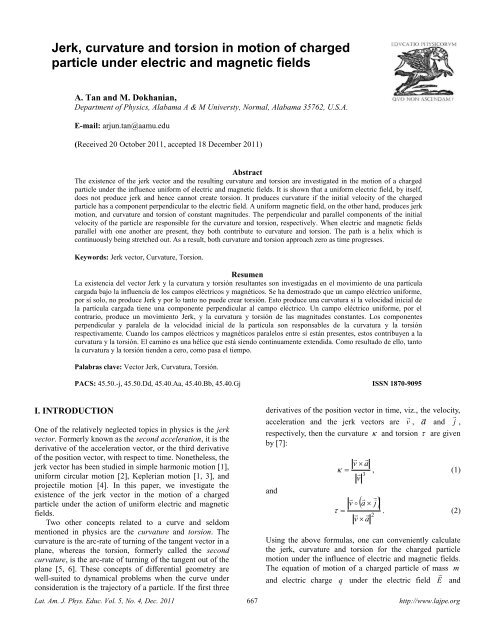
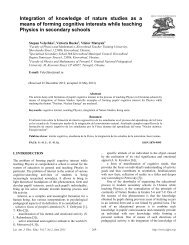
![Diversas formas de visualizar estados en un sistema cuántico [PDF]](https://img.yumpu.com/51151303/1/190x245/diversas-formas-de-visualizar-estados-en-un-sistema-cuantico-pdf.jpg?quality=85)

![Precession and nutation visualized [PDF]](https://img.yumpu.com/50786044/1/190x245/precession-and-nutation-visualized-pdf.jpg?quality=85)
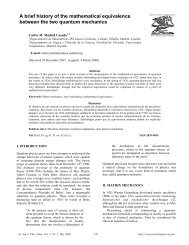
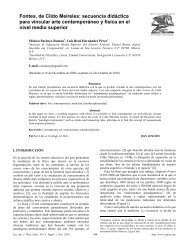
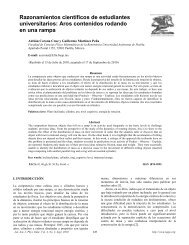

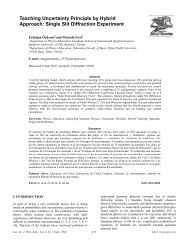
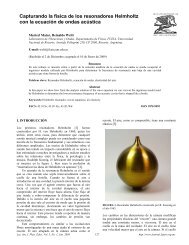
![Index [PDF] - Latin-American Journal of Physics Education](https://img.yumpu.com/47984121/1/190x245/index-pdf-latin-american-journal-of-physics-education.jpg?quality=85)
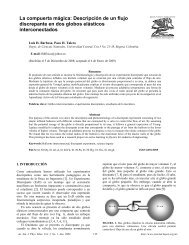
![Flujo de agua en botellas como experimento didáctico [PDF]](https://img.yumpu.com/43536300/1/190x245/flujo-de-agua-en-botellas-como-experimento-didactico-pdf.jpg?quality=85)
